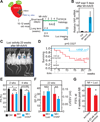Cardiac-specific YAP activation improves cardiac function and survival in an experimental murine MI model
- PMID: 24833660
- PMCID: PMC4104149
- DOI: 10.1161/CIRCRESAHA.115.303632
Cardiac-specific YAP activation improves cardiac function and survival in an experimental murine MI model
Abstract
Rationale: Yes-associated protein (YAP), the terminal effector of the Hippo signaling pathway, is crucial for regulating embryonic cardiomyocyte proliferation.
Objective: We hypothesized that YAP activation after myocardial infarction (MI) would preserve cardiac function and improve survival.
Methods and results: We used a cardiac-specific, inducible expression system to activate YAP in adult mouse heart. Activation of YAP in adult heart promoted cardiomyocyte proliferation and did not deleteriously affect heart function. Furthermore, YAP activation after MI preserved heart function and reduced infarct size. Using adeno-associated virus subtype 9 (AAV9) as a delivery vector, we expressed human YAP (hYAP) in the adult murine myocardium immediately after MI. We found that AAV9:hYAP significantly improved cardiac function and mouse survival. AAV9:hYAP did not exert its salutary effects by reducing cardiomyocyte apoptosis. Rather, AAV9:hYAP stimulated adult cardiomyocyte proliferation. Gene expression profiling indicated that AAV9:hYAP stimulated expression of cell cycle genes and promoted a less mature cardiac gene expression signature.
Conclusions: Cardiac-specific YAP activation after MI mitigated myocardial injury, improved cardiac function, and enhanced survival. These findings suggest that therapeutic activation of YAP or its downstream targets, potentially through AAV-mediated gene therapy, may be a strategy to improve outcome after MI.
Keywords: heart failure; myocardial infarction; regeneration; survival.
© 2014 American Heart Association, Inc.
Conflict of interest statement
The authors have no conflicts of interest to disclose.
Figures








Comment in
-
Hippo in the path to heart repair.Circ Res. 2014 Jul 18;115(3):332-4. doi: 10.1161/CIRCRESAHA.114.304389. Circ Res. 2014. PMID: 25035132 Free PMC article. No abstract available.
References
Publication types
MeSH terms
Substances
Grants and funding
LinkOut - more resources
Full Text Sources
Other Literature Sources
Medical
Molecular Biology Databases
Research Materials

